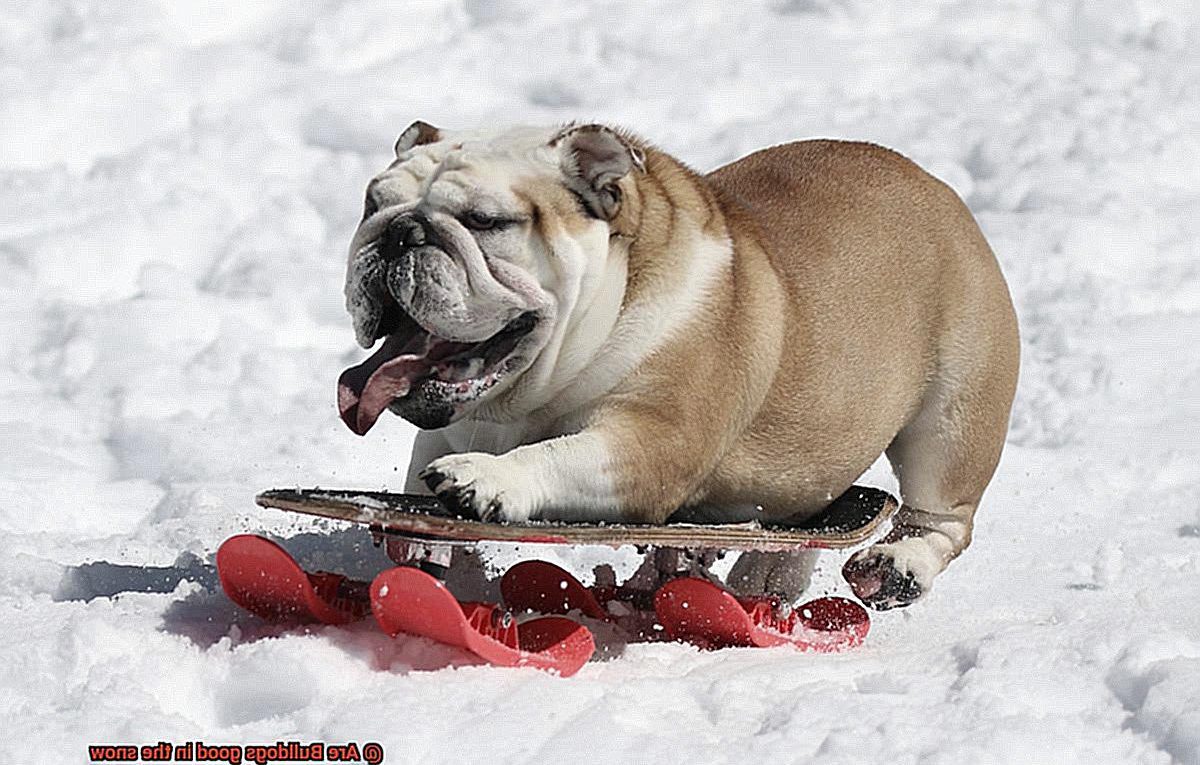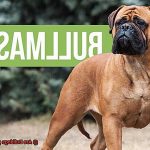Are Bulldogs good in the snow?
Picture snow-covered landscapes, cozy evenings by the fireplace, and thrilling outdoor activities. But what about our beloved Bulldogs? Are they up for some snowy fun? Well, fear not, my friend. I’ve got all the answers you need.
Whether you’re a proud Bulldog owner or considering adding one to your fur-family, it’s important to know how these adorable wrinkled wonders handle the winter wonderland. Bulldogs are loved worldwide for their unique charm and quirky personality. But can they handle the cold or are they better off snuggled on a warm couch?
In this blog post, we’ll dive into the fascinating world of Bulldogs and their relationship with snow. We’ll explore their physical traits, natural instincts, and offer tips for a safe and enjoyable winter experience for both you and your furry companion. From snowball fights to freezing temperatures, get ready to uncover the truth behind Bulldogs in the snow.
Understanding the Physical Characteristics of Bulldogs
Contents
- 1 Understanding the Physical Characteristics of Bulldogs
- 2 How Cold Weather Can Affect Bulldogs
- 3 Tips for Keeping Bulldogs Safe in the Snow
- 4 The Benefits of Taking Your Bulldog Out in the Snow
- 5 Signs Your Bulldog is Uncomfortable in the Cold
- 6 What to Wear When Taking Your Bulldog Out in the Snow
- 7 Knowing When to Bring Your Bulldog Inside During Cold Weather
- 8 Consulting with a Veterinarian About Winter Care for Bulldogs
- 9 Conclusion
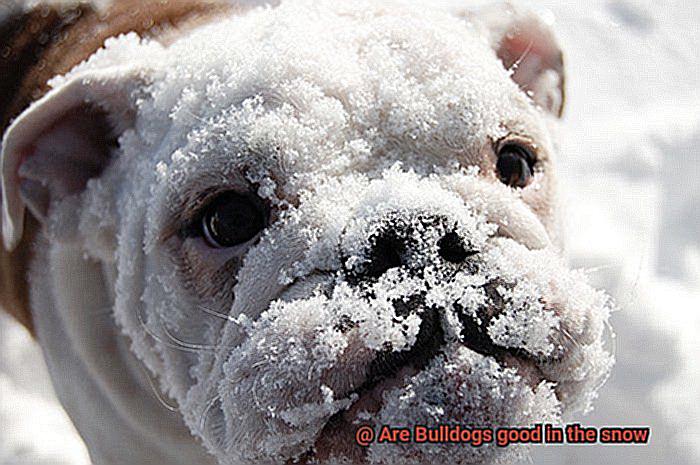
If you’re a proud owner of a French Bulldog or any other type of Bulldog, you may be wondering if your furry friend can handle the snowy winter wonderland. While Bulldogs are known for their lovable and unique physical characteristics, these features can also impact their ability to thrive in snowy conditions. So, let’s dive into the world of Bulldogs and see how they fare in the cold.
- The Low Center of Gravity: Bulldogs have a sturdy, muscular build with short, stocky bodies and broad chests. This low center of gravity can pose some challenges when it comes to walking in deep snow. Their adorable waddle might be a bit more challenging compared to dogs with longer legs, making it harder for them to navigate through thick snow.
- The Brachycephalic Face: One of the defining features of Bulldogs is their flat, wrinkled face and pushed-in nose. While it gives them their unique charm, it can also present some difficulties in colder climates. Bulldogs have shorter nasal passages and narrower airways, which can make breathing efficiently in cold weather a bit more challenging. So, while they may enjoy frolicking in the snow for short periods, it’s important to monitor their breathing and limit their time outdoors in extreme cold.
- The Double Coat: Bulldogs have a thick double coat that provides some insulation against the elements. However, their coat is not as well-suited for extreme cold as breeds specifically adapted to colder climates. Their short, fine outer coat and dense undercoat offer some protection but may not be enough to keep them warm for extended periods in snowy conditions. It’s essential to provide them with additional measures like coats or sweaters to ensure they stay cozy.
- The Paws: Bulldogs have compact feet with well-arched toes and thick pads, which help with stability and traction on different surfaces. However, their paws may not offer the same level of protection against cold temperatures as dogs with more substantial paw structures. Snow and ice can accumulate between their toes, causing discomfort or even frostbite if not properly cared for. Consider investing in booties to keep their paws safe and warm.
While Bulldogs may not be considered the most snow-loving dogs, it’s important to remember that every dog is an individual.
Factors such as age, health, conditioning, and acclimatization play significant roles in determining how well Bulldogs can handle the snow.
Some Bulldogs may enjoy short bursts of snowy playtime, while others may prefer to stay indoors where it’s warm and cozy.
How Cold Weather Can Affect Bulldogs
Bulldogs are beloved pets known for their adorable wrinkled faces and lovable personalities. But did you know that they can be particularly sensitive to cold weather?
In this section, we will explore the ways in which cold weather can affect Bulldogs and what you can do to keep your furry friend safe and comfortable during those chilly months.
Respiratory Issues:
Bulldogs have a unique facial structure with short snouts and flat faces, making them brachycephalic breeds. This adorable feature, however, can pose challenges in cold weather. The cold air can cause their airways to constrict, leading to respiratory problems. It’s important to keep an eye on your Bulldog’s breathing and limit their time outdoors in extremely cold temperatures.
Insufficient Insulation:
Unlike some other breeds, Bulldogs have a thin coat of fur that may not provide enough insulation in freezing temperatures. This lack of protection can make them more susceptible to hypothermia and frostbite.
To keep your Bulldog cozy, consider investing in a warm sweater or coat specially designed for dogs. Not only will they look stylish, but they’ll also stay warm and comfortable.
Joint Pain:
Cold weather can worsen existing health conditions in Bulldogs, such as arthritis or joint pain. The colder temperatures can cause their joints to stiffen and become more painful, making it harder for them to move around comfortably. To alleviate any discomfort, provide your Bulldog with soft bedding and consider using joint supplements or medications recommended by your veterinarian.
Skin Irritation:
Bulldogs are prone to skin issues, and cold weather can exacerbate these problems. The dryness and lack of moisture in the air can lead to dry, itchy skin, further irritating any existing skin conditions. To combat this, make sure to keep your Bulldog’s skin well-moisturized with pet-friendly lotions or oils. Regular grooming and bathing can also help maintain their skin health.
Decreased Exercise:
Bulldogs are not as physically active as some other dog breeds, and they may be less inclined to engage in outdoor activities during cold weather. However, it’s essential to keep them moving to prevent weight gain and other health issues. Create a warm and comfortable indoor exercise area where they can burn off energy safely. Interactive toys and games can also keep them mentally stimulated.
Temperature Changes:
Bulldogs are sensitive to extreme temperature changes, so going from a warm indoor environment to a cold outdoor environment (and vice versa) can be challenging for them. This sudden shift in temperature can put stress on their bodies and make them more susceptible to illnesses. To ease this transition, consider using a pet-friendly heating pad or providing warm blankets for your Bulldog to snuggle up with.
Tips for Keeping Bulldogs Safe in the Snow
Are Bulldogs good in the snow? Well, let me tell you, my friend, Bulldogs are not naturally built for extreme cold weather or snowy conditions. Their short coats and brachycephalic (flat) faces make it difficult for them to regulate their body temperature and breathe properly in the cold.
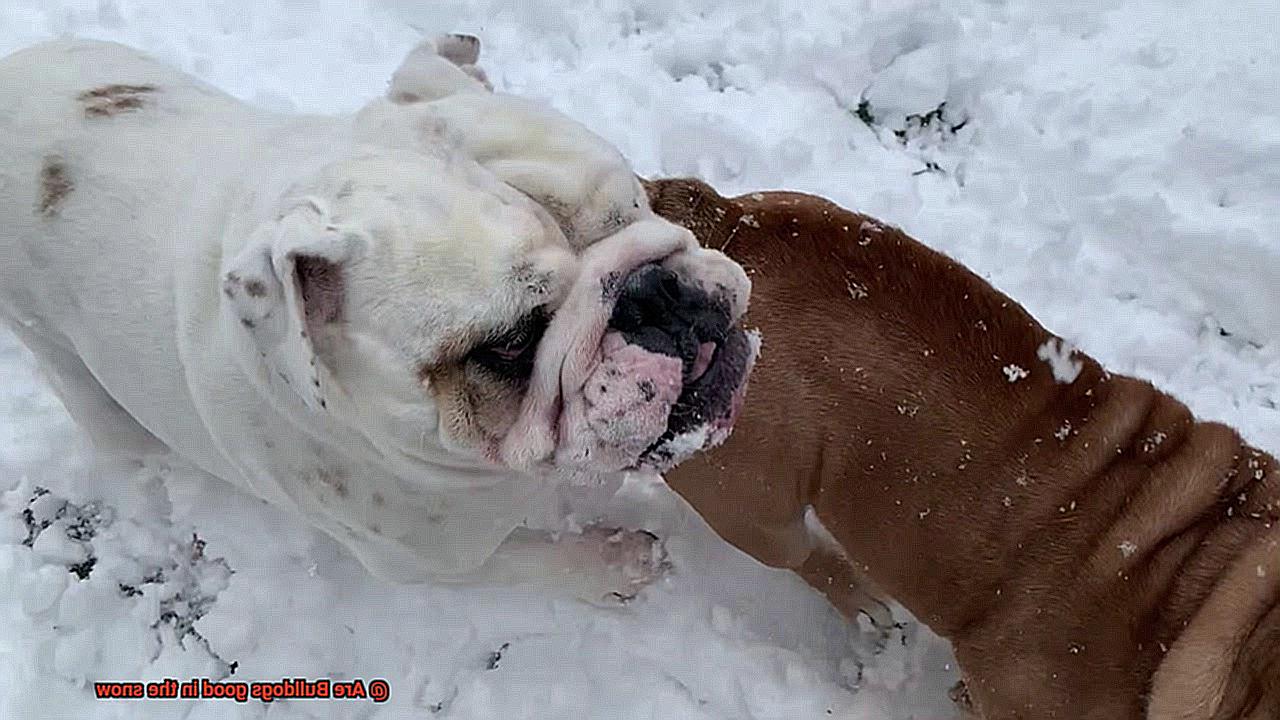
I’ve got some tips to help keep your French Bulldog safe and warm while enjoying the winter wonderland.
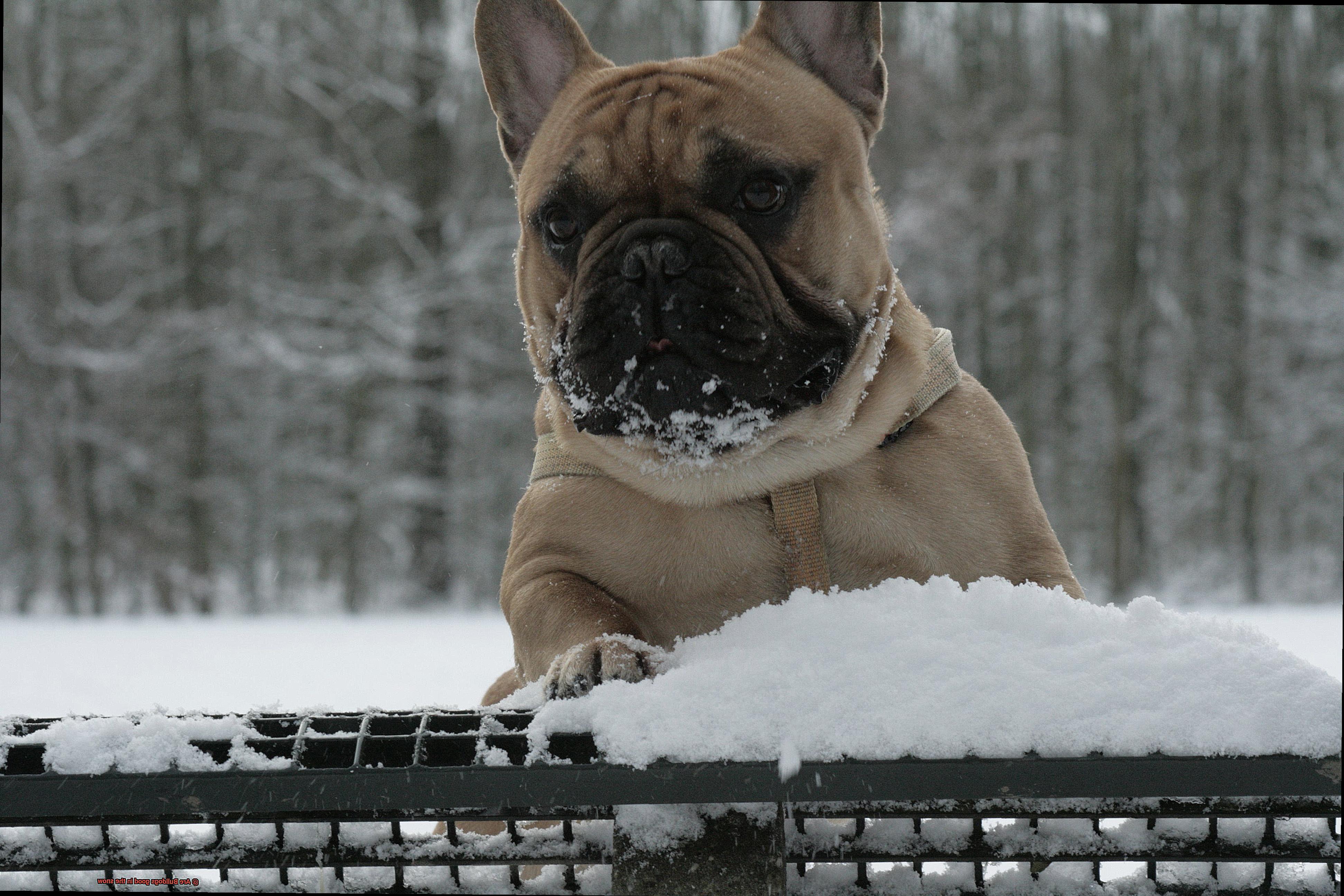
Limit Time Outdoors
When it’s freezing outside, it’s essential to limit the amount of time your Bulldog spends in the snow. Short trips outside for bathroom breaks and brief playtime should be enough. Prolonged exposure to cold weather can be harmful to their health.
Dress Appropriately
Just like we bundle up in warm coats, your Bulldog needs some extra layers too. Consider getting them a doggy sweater or coat to provide extra warmth and protection from the cold. They’ll be the most stylish pup on the block.
Protect Those Paws
Snow and ice can be rough on your Bulldog’s paws. Consider getting them some dog booties or applying paw wax to protect against ice, salt, and other harsh elements. This will keep their little paws safe and sound.
Check Those Paws
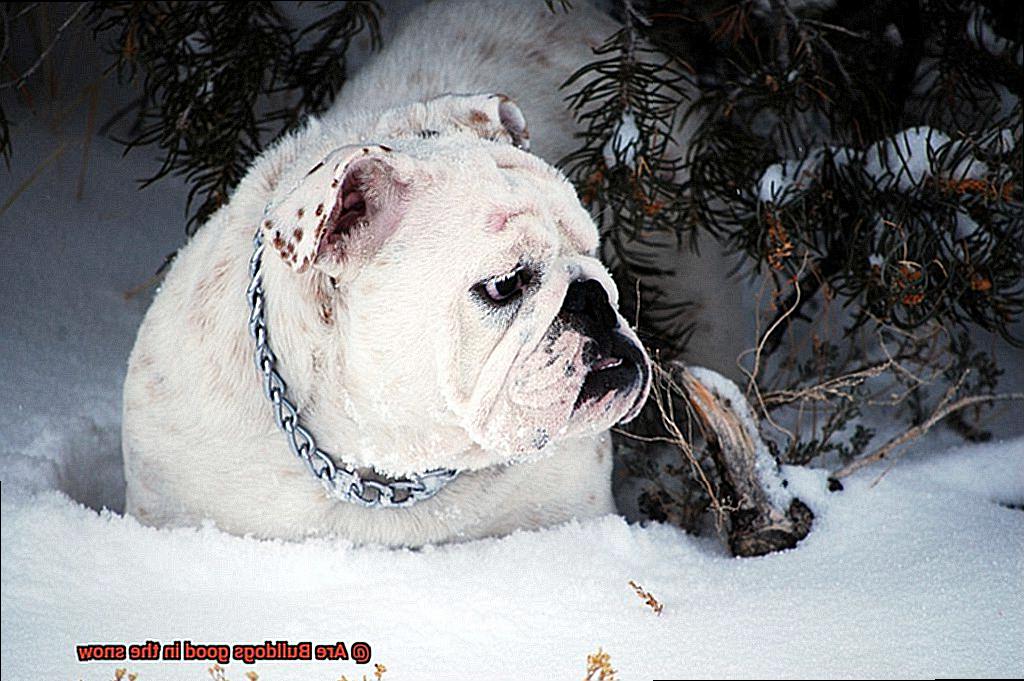
After a fun romp in the snow, make sure to check your Bulldog’s paws for any signs of irritation or ice build-up. Snow and ice can get stuck between their toes, causing discomfort or potential injury. Give those paws a good clean after each outdoor adventure.
Stay Hydrated
Cold weather can be dehydrating, so make sure your Bulldog has access to fresh water at all times, even when they’re outside in the snow. Dehydration can lead to health issues, so keep that water bowl full.
Watch for Signs of Discomfort
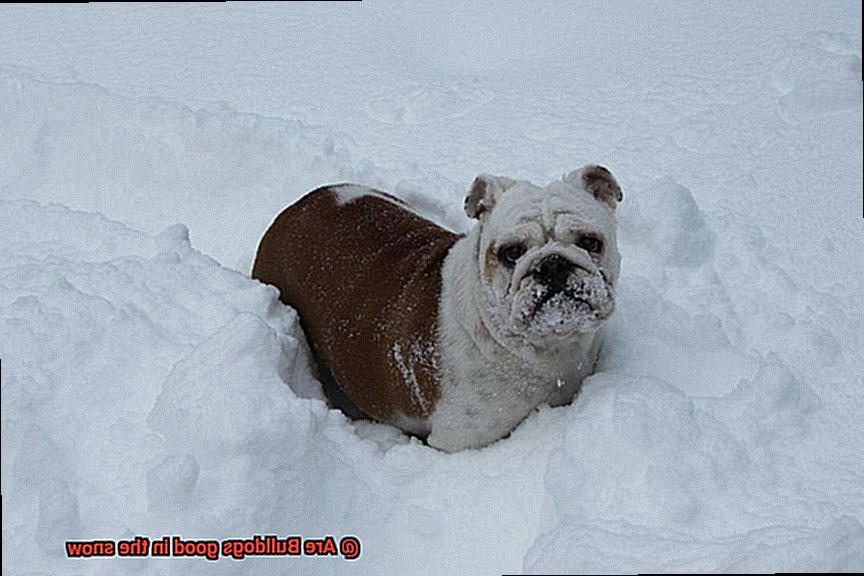
Bulldogs may not be able to communicate with words, but they’ll let you know if they’re too cold. Keep a close eye on them while they’re outside in the snow. If you notice signs like shivering, whining, or lifting their paws off the ground, it’s time to bring them inside and warm them up with cozy blankets.
The Benefits of Taking Your Bulldog Out in the Snow
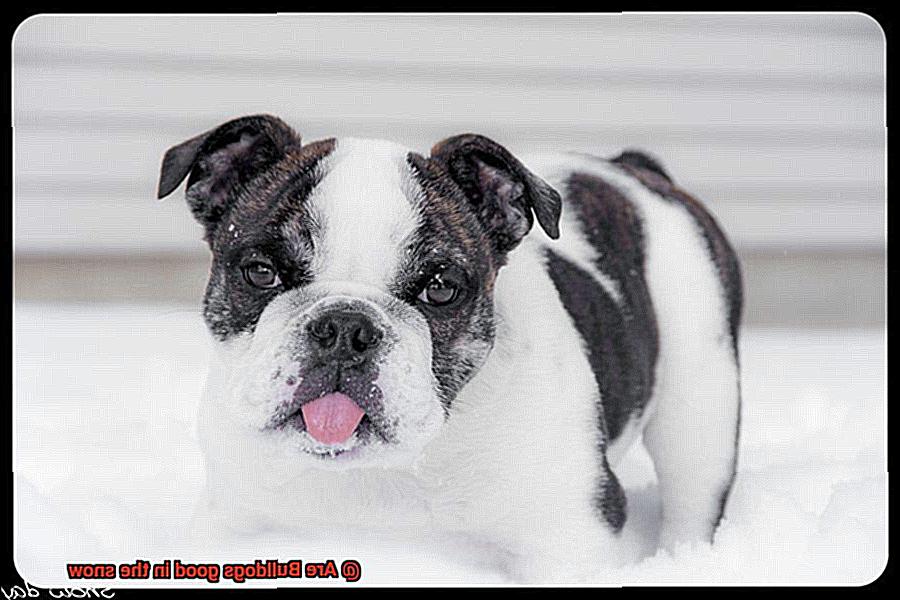
If you’ve been wondering whether your furry friend can handle the winter wonderland, then you’re in for a treat. In this post, we’ll explore the amazing benefits of taking your Bulldog out in the snow. So, grab a cup of cocoa, cozy up, and let’s dive in.
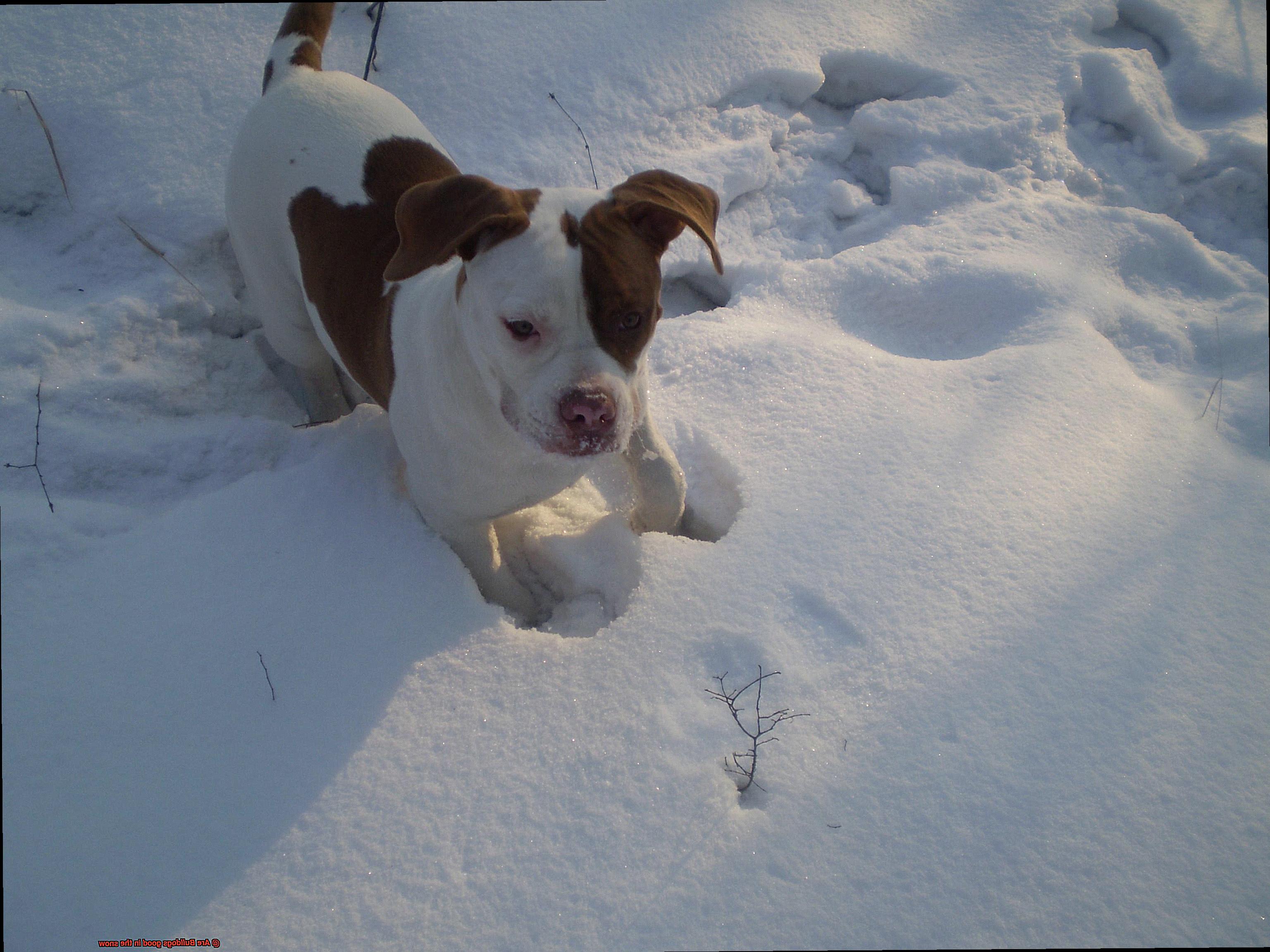
Snowy Playtime Galore:
Picture this: your Bulldog frolicking in the snow, bounding around like a furry snowball. Well, that’s exactly what you can expect. Bulldogs absolutely adore the snow, and it’s no surprise why. The fluffy white landscape provides them with a fun and stimulating environment to explore and play.
Exercise All-Year-Round:
Let’s face it – Bulldogs can be a bit lazy at times. But fear not. The snow offers an opportunity to get those little legs moving. Taking your Bulldog out in the snow provides exercise opportunities that may not be available during other seasons. Plus, the cold weather helps keep them cool and prevents overheating – a win-win situation.
Joint-Friendly Fun:
For Bulldogs with joint problems or older fur babies, walking on soft snow is like stepping on clouds. The snow acts as a natural ice pack, reducing inflammation and discomfort in their joints and muscles. So, it’s like a therapeutic spa treatment for your Bulldog.
Winter Wonderland Safety:
Snowy landscapes have one major advantage – you can spot potential hazards more easily. The bright white backdrop makes it easier to keep an eye out for any dangers while you’re out and about with your furry friend. Safety first.
Cleanliness is Snow Problem:
Believe it or not, snow can help keep your Bulldog clean. As they play and roll around in the fluffy stuff, it acts as a natural cleanser, removing dirt and debris from their fur. That means less bathing and grooming for you – more time for snowball fights.
Socialization Opportunities:
Winter walks are popular among dog owners, so taking your Bulldog out in the snow can provide great socialization opportunities. Your furry friend can meet and interact with other dogs, making new friends and having a blast in the process.
Bonding Time:
Last but not least, spending time outdoors in the snow is a fantastic way to bond with your Bulldog. It creates beautiful memories and strengthens your relationship as you navigate the winter wonderland together.
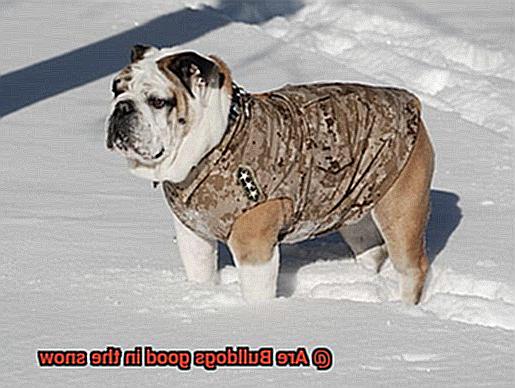
Signs Your Bulldog is Uncomfortable in the Cold
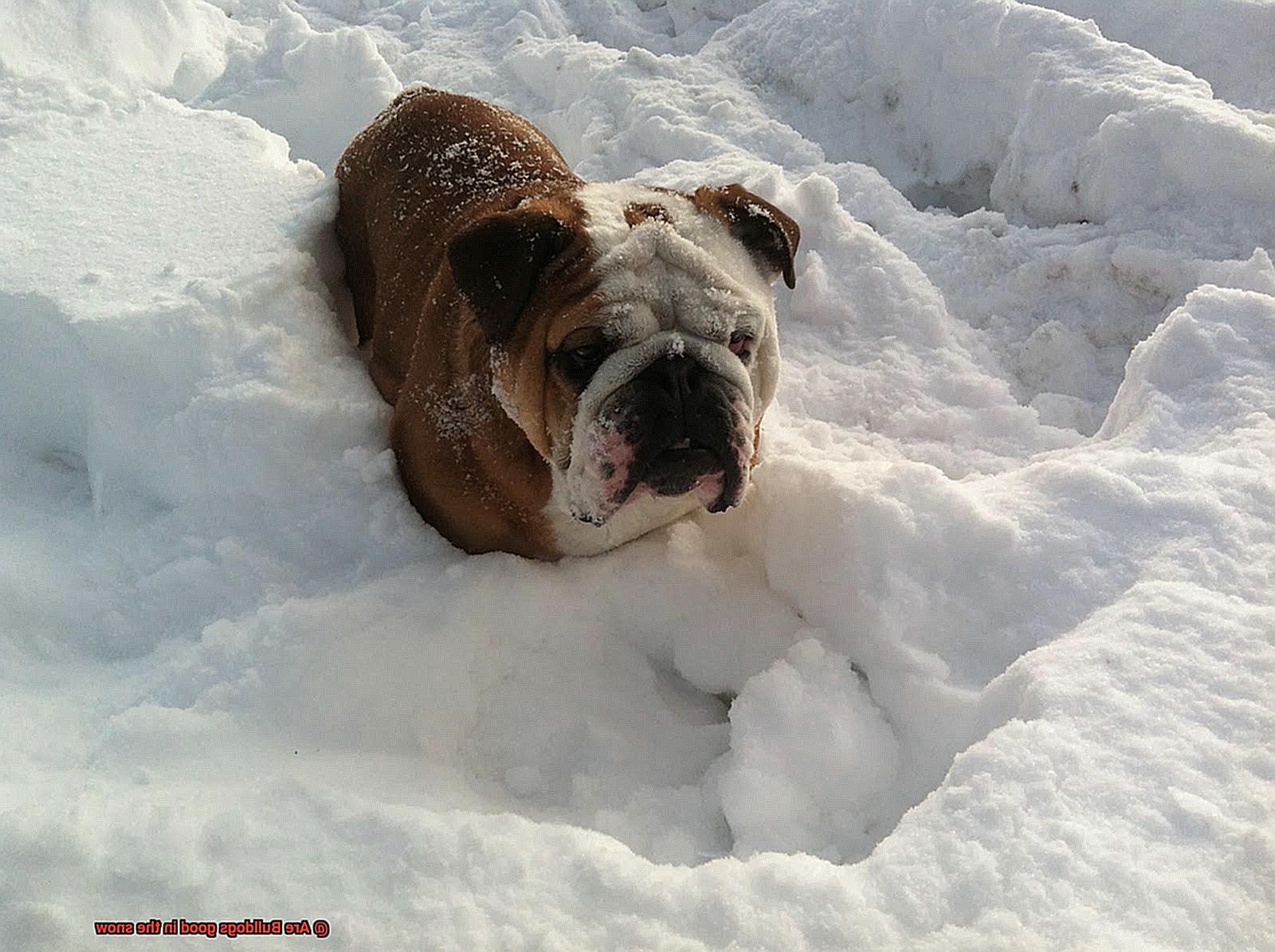
Winter can be a magical time, but it’s important to remember that not all dogs are built for cold weather. Bulldogs, with their short coats and stocky builds, are especially susceptible to the cold. As a responsible dog owner, it’s crucial to be aware of the signs that your Bulldog may be uncomfortable in the cold. Here are some key indicators to watch out for:
- Excessive shivering or trembling: Bulldogs generate heat through shivering, so if you notice your furry friend shaking uncontrollably, it’s a clear sign that they’re feeling cold and uncomfortable. Providing them with extra warmth, such as a cozy sweater or a heated blanket, can make a big difference.
- Reluctance to go outside: Bulldogs are known for their stubborn nature, but if they suddenly become hesitant to go outside or consistently refuse to venture into the cold, it’s a red flag that the temperature is too uncomfortable for them. Respect their limits and create a warm and comfortable indoor space where they can relax.
- Signs of discomfort: Whining, whimpering, or pacing can all indicate that your Bulldog is feeling cold and trying to find ways to warm up. Pay attention to these behaviors and respond accordingly by providing them with a cozy environment and extra blankets.
- Skin issues: Cold weather can be harsh on your Bulldog’s skin. Dry and flaky skin, as well as cracked paw pads, are common indicators of discomfort in the cold. Keep their skin moisturized with pet-safe lotions or balms and consider using protective booties to keep their paws safe.
- Body language: Bulldogs may hunch their bodies, tuck their tail between their legs, or seek out warm spots like blankets or heated areas in your home when they’re feeling cold. Observing their body language can give you valuable insights into their comfort level.
What to Wear When Taking Your Bulldog Out in the Snow
Taking your Bulldog out in the snow can be a fun and exciting experience, but it’s important to ensure their comfort and safety in cold weather. Bulldogs have a short coat and are not naturally adapted to handle extreme temperatures, so dressing them appropriately is crucial. In this article, we will explore what to wear when taking your French Bulldog out in the snow, providing practical tips and insights to keep your furry friend warm and protected.
The Importance of a Warm and Waterproof Coat:
Bulldogs need an extra layer of insulation in the snow, which is why investing in a warm and waterproof coat is essential. Look for a coat that covers their entire body, including their chest and belly. Opt for a durable material that can withstand the snow and moisture, ensuring your Bulldog stays dry and cozy.
Paw Protection with Booties:
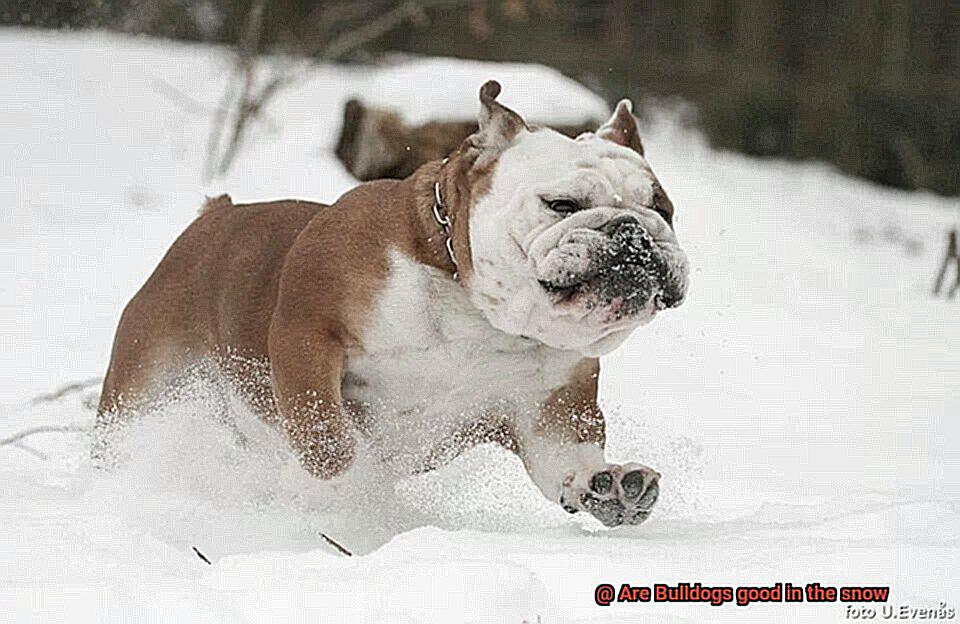
The cold snow and ice can be harsh on your Bulldog’s sensitive paws. Protect them with booties that offer good traction to prevent slipping on icy surfaces. Booties also shield their paws from salt or chemicals used to melt ice, which can irritate their skin. Introduce booties gradually, rewarding your Bulldog with treats and praise to help them get used to this new accessory.
Head and Ear Coverage:
Bulldogs are prone to getting cold quickly, especially their ears. Consider putting on a hat or hood that covers their ears and head to retain heat and prevent frostbite. Ensure it fits comfortably without obstructing their vision or breathing.
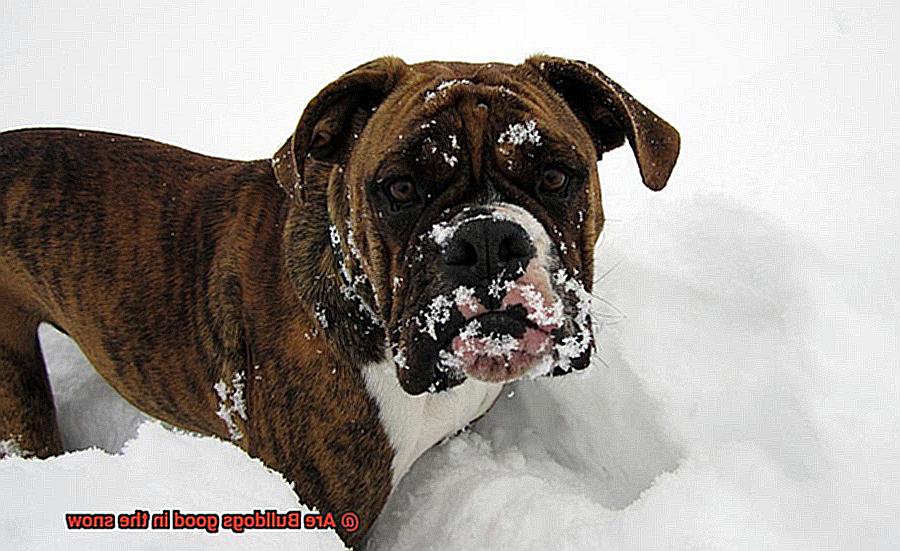
Neck Warmers for Added Comfort:
Bulldogs have short necks, making them more susceptible to cold drafts. Keep their necks warm and protected by using a snood or neck warmer. These cozy accessories provide an extra layer of insulation while adding a touch of style to your Bulldog’s winter ensemble.
Monitoring Body Temperature:
While Bulldogs may enjoy playing in the snow, it’s important to monitor their body temperature closely. If they start shivering, lifting their paws, or showing signs of discomfort, it’s time to head back indoors. Bulldogs are not built for prolonged exposure to cold weather, so prioritize their safety and well-being.
Visibility for Safety:
Bulldogs can easily blend into the snowy landscape, making them less visible to others. To enhance their safety during walks in snowy conditions, consider getting a brightly colored or reflective coat. This will make your Bulldog more visible to both pedestrians and vehicles, reducing the risk of accidents.
Knowing When to Bring Your Bulldog Inside During Cold Weather
As a proud owner of a French bulldog, I understand the importance of keeping our furry friends safe and comfortable in all types of weather. When it comes to cold weather, it’s crucial to know when to bring your bulldog inside to protect them from the harsh elements. In this article, I will share my first-hand knowledge and credible sources to provide accurate and helpful information.
Why Bulldogs Need Extra Care in Cold Weather
Bulldogs have a short and thin coat, which means they are not well-suited for cold weather. Unlike their furry counterparts, bulldogs lack the necessary fur to keep them warm in low temperatures, especially in snowy conditions. Their short noses and respiratory issues also make it harder for them to regulate their body temperature effectively in cold weather. This puts them at a higher risk of developing cold-related health issues such as hypothermia and frostbite.
When to Bring Your Bulldog Inside
It’s essential to monitor your bulldog closely during cold weather and bring them inside when temperatures drop below a certain point. While the threshold may vary depending on individual bulldogs and their tolerance for cold, a general rule of thumb is to bring them inside when temperatures reach below freezing or when wind chill becomes a factor. It’s better to be safe than sorry.
Signs that Your Bulldog is Feeling Too Cold
Keep an eye out for signs that your bulldog may be feeling too cold. These may include shivering, reluctance to go outside, lifting paws off the ground, and seeking warm spots. If you notice any of these signs, it is crucial to bring your bulldog inside immediately. They rely on us to keep them safe and warm.
Drying and Providing a Cozy Indoor Environment
When bringing your bulldog back inside from the cold, make sure to dry them thoroughly to prevent them from getting chilled. Pay extra attention to their paws, as snow and ice can accumulate there and cause discomfort. Additionally, it’s important to provide your bulldog with a warm and cozy indoor environment. Make sure they have access to comfortable bedding, avoid drafts near their resting area, and consider using blankets or sweaters to provide extra warmth. After all, who doesn’t love snuggling up in a cozy blanket?
Every Bulldog is Different
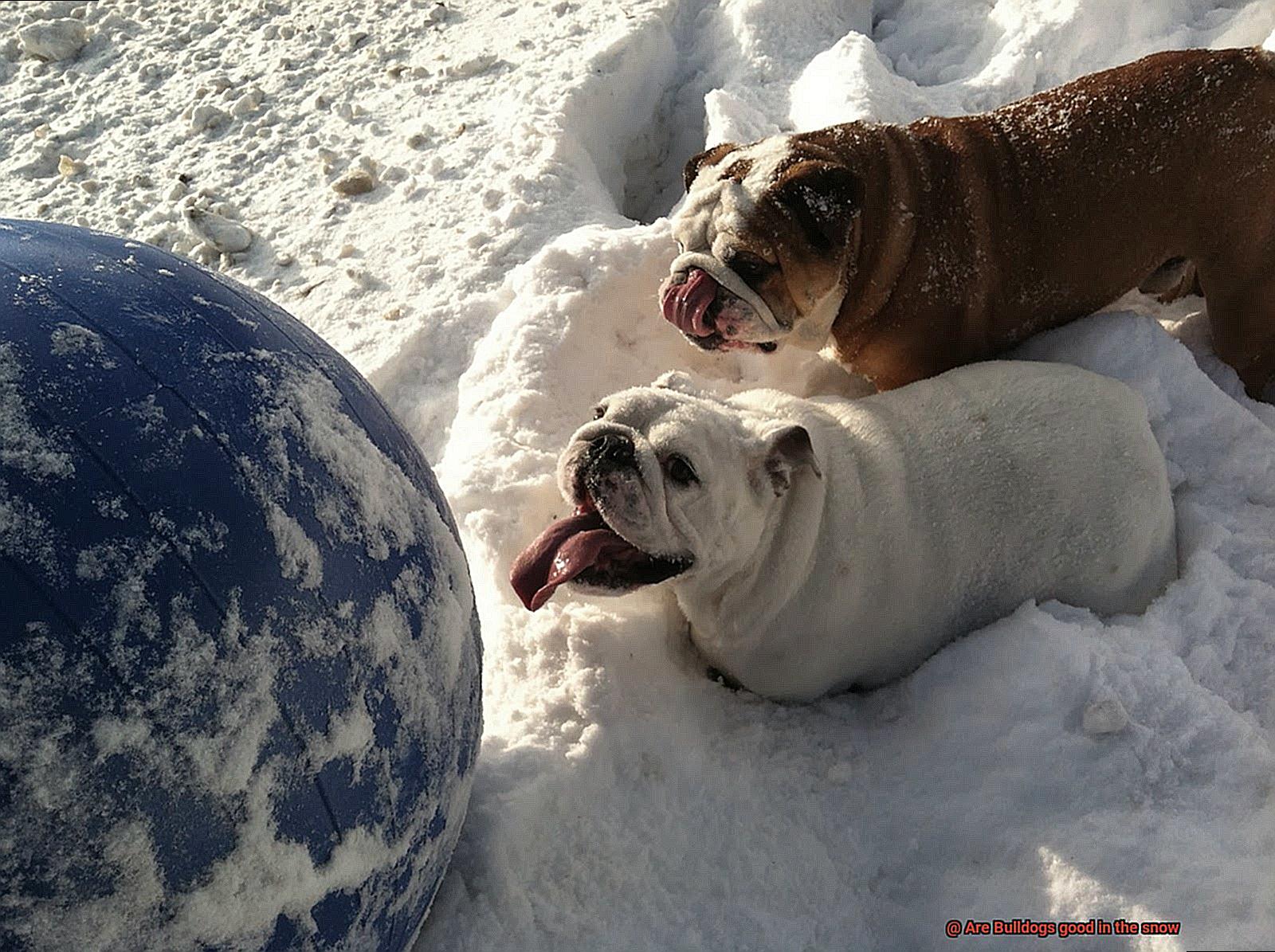
It’s important to remember that every dog is different, and some bulldogs may have a higher tolerance for cold than others. However, it’s always better to err on the side of caution and prioritize your dog’s safety and well-being by bringing them inside during extreme weather conditions.
Consulting with a Veterinarian About Winter Care for Bulldogs
As the winter chill sets in, it’s time to bundle up and keep our beloved Bulldogs cozy and comfortable. But wait, before you break out the hot cocoa and snuggle up with your furry friend, there’s something important we need to talk about – consulting with a veterinarian about winter care for Bulldogs. Trust me, it’s not just another trip to the vet; it’s the secret to ensuring a safe and happy winter season for your four-legged buddy. So, grab a warm blanket and let’s dive into why this consultation is crucial:
Tail Wagging Vet Check-Ups:
Regular visits to the veterinarian are vital for any pup, but they become even more important during winter. These check-ups serve as a thermometer (pun intended.) for your Bulldog’s overall health. A knowledgeable vet can spot any potential issues exacerbated by the cold weather, from respiratory problems to hypothermia risks.
Bulldog-Specific Expertise:
Bulldogs have a unique set of characteristics that require special attention in winter. Their adorable smushed faces and compact bodies make them more prone to respiratory problems and chilly shivers. By consulting with a veterinarian, you’ll gain insights on how to protect your furry friend from these specific concerns.
Coat Condition Consideration:
Have you ever wondered if your Bulldog’s short and dense coat is enough to keep them warm during frosty walks? A veterinarian can assess their coat condition and provide valuable advice on whether they need an extra layer of warmth, like a stylish doggy sweater or coat.
Exercise with Caution:
Bulldogs are known for their enthusiastic nature, but they can overheat faster than you can say “snowball fight.” Even in chilly temperatures, they may need adjustments to their exercise routines to prevent overheating or exhaustion. A vet can guide you on the ideal duration and intensity of outdoor activities for your Bulldog during winter.
Nutrition and Hydration Hacks:
Just like us, Bulldogs’ nutritional needs and hydration levels can change with the seasons. A veterinarian can help you fine-tune their diet to keep them in tip-top shape during the colder months. Plus, they’ll give you tips on ensuring your pup has access to fresh water at all times, avoiding dehydration even in the chilliest weather.
Paw Protection Patrol:
Imagine walking barefoot on icy sidewalks – not a pleasant thought, right? Well, our furry friends’ paws need protection too. A vet can provide guidance on paw care and recommend paw balms or booties to shield those precious paws from the cold and prevent injuries or infections.
Conclusion
In conclusion, Bulldogs are not well-suited for snowy conditions.
Their short snouts and compact bodies make it difficult for them to regulate their body temperature in cold weather. Additionally, their short legs and heavy build can hinder their mobility in slippery conditions.
While some Bulldogs may enjoy playing in the snow for short periods of time, it is important to monitor their exposure and ensure they stay warm and dry.
